 Most of us are familiar with English walnuts, but black walnuts are lesser known and far better -- rich and sweet, the flavor suggests a hint of maple syrup! Black walnut processing is messy, and there is a lot less nutmeat than with English walnuts. You have to wipe away the gooey outer covering by hand and wash them in water to get to the actual nut, then lay it out to dry. For a neat second use, you can also boil the husks in water and use the mixture as a brown dye.
Most of us are familiar with English walnuts, but black walnuts are lesser known and far better -- rich and sweet, the flavor suggests a hint of maple syrup! Black walnut processing is messy, and there is a lot less nutmeat than with English walnuts. You have to wipe away the gooey outer covering by hand and wash them in water to get to the actual nut, then lay it out to dry. For a neat second use, you can also boil the husks in water and use the mixture as a brown dye.
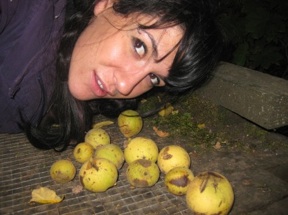
In late September here the outer covering appears green, but by late November they look like black tennis balls on the leaf-covered forest floor.
Once the nuts are dry, a conventional nutcracker won't do! I found that the easiest way to break open a black walnut is also the most primitive: With a big rock! Anyone can do it regardless of strength. Gravity does all the work as long as the rock is heavy enough. And it's quite fun!
Acorns were once a staple of indigenous people here, and I can see why! The best part of the day was making acorn flour pancakes! I took a few tablespoons of the flour and mixed it with water and mashed walnuts. The walnuts offered a surprising amount of oil. I put the batter in a non-stick frying pan on high heat. It was amazingly satisfying. There was a slight bitter aftertaste, so I think mixing in banana and honey or some sweet berries would make acorn pancakes completely incredible!
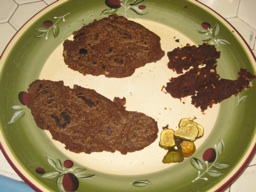
As I mentioned earlier, transforming a few gallons of acorns into flour took more than a day's work, even with eight people helping out. We cracked the shells with a hammer, extracted the nutmeat with our fingernails, ground it up, and then boiled it and strained it twice to get the astringent properties out. Then it had to dry. See the photo below, to the right, to know what the acorn flour looks like.
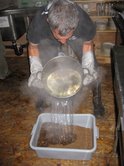
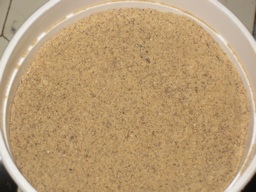
Another highlight was a visit from Jan Lundberg, who brought a gift of cherry-sized feral plums he found growing in an abandoned orchard and let dry in the sun. They were much smaller than cultivated prunes.
Breakfast was a broth made from boiling some stinging nettle greens that I had harvested and dried in the early summertime. Nettle resembles spinach in flavor and is high in iron, calcium, potassium, manganese, vitamins A, C, and D, and fatty acids. Reaching a height up to 7 feet, this plant grows on the edges of paths in forests and on river banks. Gathering it can be tricky because it is covered in tiny hairs that sting you when you touch it. Cooking and drying the plant neutralizes the sting, but it's a great idea to wear gloves when you're picking it fresh. However, if you have arthritis, you might actually like to sting yourself, because some people claim it relieves joint pain.

In the afternoon I went foraging at a northeast Portland park with naturalist Tony Kimbro and we found four figs still on a tree! I made them into fig chips by slicing them and baking them in the oven on 200 degree heat for an hour. You can identify a fig tree by its distinctive three-lobed leaves and branches that seem to grow straight out of the ground rather than from a central trunk. The green fruits are sweetest when soft but they are edible at any texture.
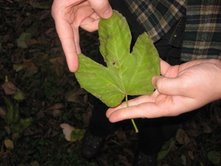
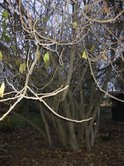
I was in a great mood today because I felt so well-fed! Carbohydrates, fats and protein! No more hunger for me! And definitely no stinky deer fat! Maybe it is possible to be a wild vegetarian after all. Native people here relied heavily on root vegetables like wapato. I'll be heading to Oregon's Sturgeon Lake on Tuesday (Day Five) with knowledgeable friends to see if we can harvest and eat some!
A reader wrote in to ask how many foragers I thought the city could support. Before Europeans came here, the native population density was somewhere between 1 and 15 people per square mile, as estimated by Portland State University anthropologist Cameron Smith. These days, Portland has more than 4,000 people per square mile and far less wild land. So my answer is: Not everybody, but more than do it presently! If you live in Portland, the web site www.UrbanEdibles.org is a great resource, offering a list of intersections where you can find all kinds of edibles, including cultivated fruit trees that lean over fences to drop their wares on public sidewalks.
* * *
TV coverage in Portland of Rebecca's wild diet:
koinlocal6.com
The Portland Oregonian, largest daily newspaper in Oregon:
Portlander tries a holiday diet of only foraged foods, by Matthew Preusch, Nov. 21, 2009 - with a link to Culture Change.
Do you have a suggestion, feedback or advice? She loves to get e-mails from Culture Change readers at This e-mail address is being protected from spam bots, you need JavaScript enabled to view it
* * * * *
See the press release for this series: Can a Portland Woman Survive On Wild Food for Thanksgiving Week?
Rebecca Lerner's introductory article posted Friday: On roadkill, seasonal foraging, and getting by with a little help from my tribe
Rebecca Lerner's FirstWays.com website.

